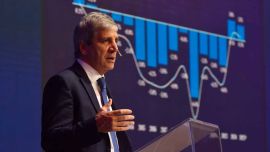After the pre-agreement with the International Monetary Fund, the Government moved forward with the request of the international body and conducted a partial devaluation, in addition to making a few measures official, such as pushing the value of the dollar up and implementing a new agro dollar.
Earlier this week, the parallel currency continued to climb and hit a new record high on Monday, which meant a cumulative increase of $62 over the last 11 days, and $211 since the beginning of the year. It partially fell to $536 by the end of the session on Tuesday.
At the start of the week, and after minister Sergio Massa’s announcements which sought to bring calm after a pre-agreeement with the International Monetary Fund, the informal market once again showed high volatility and reached an unprecedented $552 (after adding $24 since it opened at $528), something analysts had been dismissing, regardless of an agreement with the IMF, partly due to the strong volatility displayed by this small market where variations are quickly exposed and devaluation gives a new floor to rates.
Andrés Reschini from F2 Soluciones, explained this to PERFIL and said: “The pressure may be eased at some point, but anyway I don’t see the blue dollar at a panic level; and thus I think that, besides any downward variation, it will continue to leap forward”, he anticipated.
Natalia Motyl, in turn, explained to PERFIL that “The new measures are a sort of devaluation which gave a floor to all dollar rates”, and added that “today the sign of maintaining a delayed exchange rate is totally unsustainable, which is why the dollarisation of portfolios accelerated”.
Among other things, Motyl pointed out that: “The market dismisses a greater rise in prices due to more expensive costs and tries to cover itself up by demanding more foreign currency”, she said and anticipated: “It’s very likely that the gap will widen over the next few days. Besides, the target of the differential exchange rate is an indicator that it may not be enough for more than USD 60 million of intervention. Today it all points to a correction of the exchange rate which may take place before the elections”, she concluded.
According to Salvador Di Stéfano, an agreement with the IMF brings peace and quiet to the market: "we won’t see a run to alternative dollars, but this may affect future inflation. I believe the scenario will play between recessive and inflationary, many prices will go up and consumption will go down”, he pointed out.
As for the possibility of a strong hike in the American currency he said: “The plan being studied is very recessive and would affect consumption. For alternative dollars to go up we need money, and here we are increasing tax pressure by 0.8% of the GDP. I don’t know if this part of the agreement is clear”, he questioned.
PASO primaries, uncertainty and the IMF
José María Segura, Chief economist and partner at PWC explained to PERFIL that in his point of view, the market dismissed any kind of agreement with the IMF and that showed in the price of bonds which are not falling and were somehow recovering.
“Now, the agreement does not give fire power to the Central Bank to avoid or prepare for what normally happens during elections, which is a transfer of portfolios from pesos to dollars, that is a dollarisation of portfolios. And somehow that’s what we probably expect will happen until the election is over", he anticipated.
According to the economist, “what we have to expect is some kind of volatility up to the general election. It partly has to do with correction, even though the exchange rate was adjusted this month, it was a bit delayed compared to the inflation”, he said. In terms of the blue dollar, he explained that “somehow some of that ground is being gained back and part of the volatility is typical of the election, which doesn’t necessarily mean it will always go up, but it will probably be exacerbated until that process is done”, he concluded.
Measures and their impact, the blue dollar is far from important
The reaction to the measures announced by Economy minister, Sergio Massa, has had immediate repercussions in the market. Perhaps eyes were turned to the jump of the blue dollar, which reached $550, more than $20 in a day. However, Lautaro Moschet, Economist from the Libertad y Progreso Foundation, stated that financial exchange rates stayed calm and did not show great ups or downs. Even shares in Argentine companies had positive variations, as did sovereign bonds, which resulted in the country risk falling.
“This is due to increasing rumours of an agreement with the IMF, which gives the government a break to face debt payments over the next few months, and, naturally, avoiding an economic collapse caused by a default”, he assured.
Concerning the hike of the blue dollar, Moschet stated that “what may be appreciated is that the announced measures caused greater fear among small savers”.
In that respect, the economist pointed out that the blue market is not representative, but small and volatile. He also said that people with a small saving capacity usually operate there, who occasionally have a little extra which allows them to buy foreign currency, or those moving undeclared money.
“Therefore, movements are usually sharp, since fear leads to a herd effect and then can remain calm, as it happened over the last few months”, he stated. “This shows a clear contrast with the MEP (exchange dollar via shares) or the CCL (exchange dollar via bonds), where daily operations move great volumes and are constant, which may reflect the ‘actual’ value of the exchange rate more accurately”, he commented.
Dollar values today
It is worth remembering that earlier it opened at $528, and following the first transactions, at 3.30 pm it hit a new historic high: $550 for sales. The MEP dollar is currently at $497.86 for purchases and $498.04 for sales.
The CCL dollar is listed at $530.85 for purchases and $542.60 for sales.
The country risk is an indicator prepared by JP Morgan measuring between the difference of US Treasury Bonds against those of other countries.
On Monday July 24th it was 2.021 basis points.
During the close of last week, the blue dollar had reached $529 and the Central Bank once again lost foreign currency with the sale of dollars and yuans.
It is worth remembering that earlier on Monday the Government announced a 10% devaluation of the savings dollar, in order to equate it to the tourist exchange rate, which means at least one less exchange rate, one of the requests of the IMF.
Thus, the 900,000 buying on average USD 150 will go from paying an exchange rate of $464.47 -which they paid until Friday- to $492.63.
Economy minister, Sergio Massa, highlighted that an agreement was reached with the IMF for the “next five months” which “takes the discussion on the Fund off the campaign”. The official announced that there would be “strong disbursements in August and November, largely covering obligations this year”.
On the other hand, he clarified that he does not expect to travel to Washington, as was speculated, because the Economy envoys “did a great job to close everything”.
Upward bonds
In the case of Argentine bonds abroad, as explained by Bloomberg, they reached their highest level in nearly six months after the International Monetary Fund and Government authorities stated on Sunday that they were near an agreement to reformulate the credit programme of USD 44 billion for the country.
Bonds with a maturity in 2030 rose by 0.7 cents to nearly 35 cents on the dollar, their highest level since early February. Values with a maturity in 2041 followed suit, rising by les 0.8 cents to 33 cents on the dollar. Both bonds were the best performing on Monday in an index of sovereign bonds in emerging markets.




















Comments